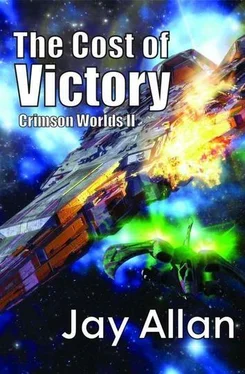The Cost of Victory
Crimson Worlds: Book II
By Jay Allan
AS Cromwell Flagship, Alliance Grand Fleet Gliese 250 System
There was a battle raging in space. Unimaginably far from Earth, around a massive space station orbiting a gas giant in a binary solar system, squadrons of ships fought each other in a desperate struggle.
In the combat command center of his battle-scarred flagship, Admiral Augustus Garret sat quietly and considered the Western Alliance fleet he commanded. Garret was young for such an assignment, but he was the hero of the Second Battle of Algol and had been in the forefront of a tremendous resurgence in Alliance fortunes after the disastrous defeats of the early war.
Like the rest of the officers busily working around him, Garret wore a tight-fitting pressure suit that allowed him to endure the G-forces he would experience during combat. The suit could also keep him alive if the hull was breached and the control center lost pressurization. That is, of course, if he wore the helmet lying next to his command chair, the one he had carelessly tossed aside.
The command center was cramped, like everything on a spaceship, and it was dominated by a massive screen, currently displaying the locations of the 164 vessels that comprised the fleet. There were 9 large blue ovals, each representing one of the capital ships under Garret's command. They were surrounded by clouds of smaller dots, the support ships and escorts of each battlegroup. On the extreme flank of the fleet was a cluster of small yellow dots, the ships of the allied PRC task group, mostly mid-sized cruisers and squadrons of small attack ships.
The Alliance capital ships were all large and powerful, but the three vessels of the new Yorktown class were something different, each a full two kilometers in length, bristling with weaponry and carrying 4 squadrons of heavy fighter-bombers. This would be the first engagement for these behemoths, and Garret was counting on their firepower to make the difference in the battle now just beginning. He'd considered transferring his flag to one of the new ships, but he'd ridden the Cromwell since the victory at Second Algol, and he wasn't going to abandon her now.
Maneuvering a space fleet in battle, with the many variables and tremendous distances involved, was a giant game of anticipating the opponent's moves - a complex exercise in making educated guesses. Augustus Garret was a master of the art, having displayed an uncanny ability to predict his adversaries' intentions.
The system in dispute was Gliese 250, well over 100 light years from Earth, and the battle taking place was large - the biggest ever fought, in fact. Gliese was a vital Caliphate choke point that had been seized in a daring surprise attack when Erik Cain's Marines boarded and captured the giant station. The system had been deep in Caliphate space until an Alliance survey team located a previously undiscovered warp gate, redrawing the strategic map in an instant. The new gate led directly from a major Alliance base to the Gliese system and provided an opportunity to launch a surprise attack on a vital sector the enemy had considered secure.
The capture of Gliese had allowed the Alliance to mount a series of follow-up campaigns against systems on the enemy's frontier, cutting off vital supply sources and dramatically changing the outlook of the war. The Alliance had been losing, but now they seized the initiative and won a series of unanswered victories.
The Caliphate's first attempt to retake the system had been repulsed, and now they and their CAC allies had assembled a massive combined fleet for a second attempt, one which was opposed by every naval unit the Alliance high command could scrape up.
The first group of invaders had come in fast, bursting through the warp gate on a carefully plotted vector that took them directly at their target, the hulking, kilometers long station. Their plan was to gut its defenses with the first task force then fight the defending fleet with a second wave twelve hours behind.
The enemy was coming through the warp gate from Alpha Cephei, which was approximately 80 light minutes from the station. The defenders had good intelligence from the scanners deployed near the gate, which transmitted their data at light speed back to the defending fleet, giving the Admiral a complete report on the enemy first wave seven hours before they entered combat range.
Unfortunately for the attackers, Admiral Garret had anticipated their strategy and positioned his ships for maximum effect. The Western Alliance fleet he commanded was large and powerful, but it was still smaller than the Caliphate-CAC force he faced, and he knew it would take every trick he had to win this fight. Conventional tactics called for meeting the invaders near the warp gate, seeking to hit the enemy before they had time to shake themselves into battle order. But no Alliance ships awaited the enemy as they emerged into Gliese space. Garret had his ships deployed back near the station, waiting. His strategy was to bleed the enemy as much as possible with his fixed defenses and then, with the odds hopefully more even, get right in their faces and fight it out to the death.
The minefields were the first thing the invaders discovered. Far thicker than the attackers anticipated, they were positioned perfectly along the path of the assaulting force. They savaged the incoming ships, which were moving at nearly 0.15c and could not apply enough thrust to evade the ECM-masked fields when they were finally detected.
The mines did not rely on a ship striking them directly, an occurrence of almost infinite improbability. Instead, they released up to 200 individual warheads, small high-thrust rockets blasted out in all directions and carrying individual payloads of up to 500 megatons, creating a large area effect. Even a near miss with one warhead could cause catastrophic damage to a target vessel. A direct hit would vaporize anything manmade.
The minefields tore apart the enemy first wave, mostly cruisers intended to strike the station as they passed, then decelerate to regroup. The attacking vessels plunged right through the most heavily mined sector, and hundreds of the devices were triggered, causing thousands of high-yield warheads to explode in the path of the enemy ships.
Garret watched the scanning reports closely. Ten, at least, of the enemy ships were destroyed outright, and 20 or more suffered significant damage. The force was depleted and disordered when they finally entered range of the station and launched a ragged salvo of missiles. The enemy fire, degraded by the damage from the minefield, was far less effective than Garret had feared, and his defensive countermeasures had been extremely effective. Launched at very high speeds and clearly targeted for the station, the missiles were on vectors Garret had predicted, which made them easy targets for the linked point defense arrays of his defending forces.
He had taken a chance, positioning his entire fleet nearly motionless, in direct support of the station. The resulting combined defense network was extremely potent against missile fire, but it left his ships out of position to engage enemy vessels directly. If the attackers had sent their capital ships in at moderate velocity, formed up for battle, Garret could have been at a disadvantage. But his instincts had been spot on. Missile after missile was intercepted, and in the end only three got close enough to harm the station - mostly surface damage and radiation penetration in outer compartments.
The station did not sit idly by and endure the enemy's fire; it unleashed a heavy missile broadside against the oncoming ships just before they entered energy weapon range. The missiles were launched on a broad spread, timed to disorder and damage the enemy ships before they entered energy weapon range.
Читать дальше












